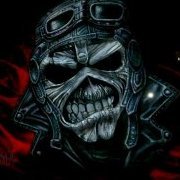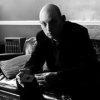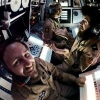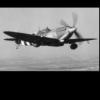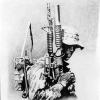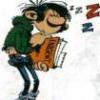Search the Community
Showing results for tags 'airacobra'.
-
Here is my interpretation of Rechkalov`s P-39N-0 Airacobra, serial 428747, Spring 1944 (as I imagine it before tail exchange and "RGA" inscription on fuselage appearance). My assumptions for "how this aircraft should look like": - cannon and guns barrels in tubular covers, wing machine guns present! - no US radio, but antenna wires remain, - silver-grey propeller blades with Hamilton-Standard marks and inscriptions, - white dot on left doors (center of gravity mark), - white front wheel caps, - interior surfaces in "Bell Green" (cockpit, engine, gear covers and gear struts) and Zinc Chromate Yellow (flaps and gear bays), - red tail tip and spinner (standard in Rechkalov`s unit at this time), - "new" Soviet red stars with white-red borders, painted directly on original American stars. 1/72 Academy kit + Part PE set + Aires/Quickboost resin engine, exhaust and main wheels + AML decals. Painted with Lifecolor acrylics.
- 14 replies
-
- 38
-

-
Kitty Hawk is to release a 1/32nd Bell P-39Q/N Airacobra kit - ref. KH32013 Source: http://www.kittyhawkmodel.com/#!kh32013/c24dx V.P.
-
Hi Here is my current build. Eduard's Bell P-39 Airacobra from the new dual pack. My second build, well kinda as im making a tank as well.. The PE cockpit looks okish.. damn fiddly to glue the levers on.. installation instructions are not great on where to stick the cockpit... as you can see it does not fit perfectly...any one else made it have advice? Weathering. pah I didn't know what I was doing so looks a messy!. The red handle things on the cockpit.. They looks odd. You have to fold a bit of PE but you can see the fold and join? Oh well it is only my second build... maybe now to add some wires and what not
-
Hi - these shots of a P 39 Airacobra and other aircraft were taken in 2013 at the Classic Jets Fighter Museum , Adelaide. It's a great museum for pottering around if you get the chance. It's very friendly, relaxed and informal. The museum consists of a show hanger and a second hanger in which aircraft are stored or being restored. The P 38, I believe, is now in the UK. Not sure how far the birdcage Corsair has progressed but it was going guns when I was there. As far as i know, it's the oldest surviving Corsair and was rescued from a lagoon. Birdcage Corsair Airworthy Boomerang Mirage and P51 tail
-
Bell P-39Q Airacobra "Brooklyn Bum-2nd", pics thanks to Mark Mills.
-
Bell P-39L/N Eduard Profipack 1:48 History The P-39 Airacobra was designed in 1937 in response to a tender by the U.S. Army Air Corps. In many respects the P-39 Airacobra was an unusual aircraft. The basic idea was to install a powerful engine as close as possible to the aircraft's centre of gravity in order to improve manoeuvrability and stability. An Oldsmobile T-9 37 mm cannon fired through an opening in the propeller spinner. The P-39 was the first American fighter to be fitted with a freely rotating nose-wheel. The Airacobra also aroused interest in the British Air Force; the RAF however later rejected the aircraft. The Russian Air Force also expressed strong interest in the aircraft and initially took delivery of 179 units. The U.S. Army Corps also equipped some of its newly formed units with the P-39, including the 8th and 35th Fighter Groups which operated out of New Guinea. Often underrated in the West the P-39 proved to be an exceptional aircraft in the Far East. Its top speed of 580 km/h was sufficient to dominate an A6M Zero in a dogfight. The Model The kit comes in an attractive top opening box with a depiction of an Airacobra flying towards the modeller. Inside, there are three sprues of bluey grey styrene, one of clear, a pre-painted etched sheet, a sheet of masks and quite a large decal sheet. The moulding is up to Eduards usual standard, being very clean with no sign of flash or other imperfections. From the few builds I’ve seen of this kit the fit appears to be pretty good and there don’t seem to be any problems with construction. The build begins with the cockpit and the fitting of the mid and rear bulkheads, two piece radio set and what I presume is the oil tank fixed to the back of the rear bulkhead. The instrument panel is an all etched affair including the panel, binnacle, centre console, plus several handles and levers, this also included the breeches of the two upper machine guns which, once folded to shape are fixed to the front face of the panel. Alternatively if etch isn’t your thing then Eduard do provide a styrene alternative and the instrument decals to use on it. The pilots seat is fitted out with etched seat belts, buckles and latches, once complete this and the instrument panel assembly are fitted to the cockpit floor along with the joystick, rudder pedals and forward bulkhead. The nose wheel bay is made up of front, rear and side bulkheads which are attached to the underside front of the cockpit floor and the propeller shaft fitted between the cockpit forward bulkhead and the bay forward bulkhead. With the cockpit assembly complete it is then fitted between the two fuselage halves along with the appropriate weight to prevent it being a tail sitter. The single piece lower wing is fitted with the two roof parts of the main undercarriage bays, landing light in the port wing, and leading edge radiator etched parts. The upper wing sections can then be attached along with the radiator intakes. The completed wing is then attached to the fuselage assembly along with the horizontal tailplanes and upper nose panel which has moulded in gun troughs. Behind the centre wing panel are three radiators which consist of both styrene and etch matrix panels. Once fitted the three radiators exhaust flaps are attached. Whilst the model is upside down the main undercarriage is fitted, each made up of the main oleo a choice of main wheels, each in two halves, one with a weighted tyre, one without. The wheels are attached to the axle and completed by the attachment of the outer bay door and separate scissor link. The inner bay doors are then fitted along with their associated actuators. The instructions then call for with either the drop tank or bomb, each made up of two halves, to be fitted along with their cradles to the wing centreline. The nose wheel is assembled in the same way as the mains and has the same choice of tyre. When assembled the wheel is fitted between the yokes of the nose wheel leg and the lower forward bay door is attached as is the scissor link which in this case is a PE part. The nose leg is then fitted into the bay along with the retraction jack and support arms, followed by the nose wheel doors. With the model the right way up the included pilot figure can now be added if required and is enclosed into the cockpit by the single piece canopy/windscreen and two doors. The exhausts, aerial mast and PE intake grille are then attached. The kit comes with a choice of three types of cannon muzzles for the spinner, and a choice of two different types of propeller blade, dependent on which choice of markings you intend to use. The separate blades are attached to the backplate followed by the fitting of the spinner. The completed propeller can then be attached to the model along with a pair of small panels either side of the nose. Finally the wing machine gun muzzles and pitot probe are attached, completing the build. Decals The large decal sheet has been printed by Cartograf, so the quality is good. The sheet provides a full set of stencils for one aircraft and markings for five different machines. The decals are very nicely printed; being pretty thin in appearance, in good register with very little sign of carrier film and are slightly on the glossy side, which should help with then settling down. The markings are for the following aircraft:- P-39N, S/n 4218354. Flown by the 345th FS, North Africa/Alghero Airfield, Sardinia, late 1943 in an olive drab over neutral grey scheme, with white fin tip and sharks mouth. P-39L, S/n 424514. Flown by the 91st FS, 81st FG from Sidi Ahmed Air Base, Tunisia, September 1943. This aircraft is in mid stone and sand scheme with olive drab panels and azure blue undersides. P-39N, flown by Lt. DeVore, 110th TRS, 71st TRG, Guasap Airfield. New Guinea, Spring 1944. Painted in olive drab over neutral grey with a white tail and red fin tip. P-39N, Flown by Gregori A Rechkalov, 16th GIAP, Spring 1945. Painted olive drab over neutral grey with a red fin tip and spinner. P-39N, flown by Nikolai G Sobolev, 21st GIAP, April 1943. Painted in olive drab, (including the spinner), over neutral grey and with a large slogan painted on the fuselage sides. Conclusion This is a lovely looking kit and having had a couple of the earlier marks released by Eduard it should be a treat to build. It’s a great looking aircraft and with the choices of colour schemes it’ll be hard to choose which to build. As with their other Profipacks it’s great to have the pre painted etch and the masks provided. Highly recommended. Review sample courtesy of
-
I m quite new on BM and found this group build thread recently. I hope you wont mind if i post one my kit here, it kinda goes under your KUTA rules, but i finished it in middle of november 2013, so if it is out of rules, i m sorry. So this kit was under my bed for over 15 years, untill i came back to models like 2months ago. The kit was almost completed (fuselage, wings and tail joined), so it needed just the undercariage, propeller, gun barells (used aires resin barels and ofc managed to break one while painting the kit) and ofc painting. It was first kit where i used airbrush and some techniques (post-shading, wash, never did it before). Sadly over the years i lost some parts and the canopy was in realy bad condition.. because i thought it ll be just aibrush test subject, i left it as it was (now kinda feel sorry for that). But after all, i was quite happy with the finish, probably bcs it was first kit finished after so many years I hope you wont mind me posting it here then.
-
A quickish build of hellers airacobra just completed,the decals were unusable so alternative leftovers from my sons hobbyboss kit were used,nice easy build glazing could be better,
-
Originally released in the 1960s and available (yet again) this year it has been superseded by the offering from OzMods . I'll be building this OOB.
-
Desert Snake Hi mates, here are some pictures of my last year finished Airacobra from Eduard. I`ve used the old but great Profipack with photoetched parts, Express Masks and no less than 6 different variants of paint shemes. Additional I used both CMK accessories for engine compartment and front armarment. The model you see represents an aircraft of 346. FS, 12.AF, Noth Africa.The 346. was the last USAF unit using the P-39 in Europe. Only used as an attack aircraft, as this type didn`t rocks as dogfighter against german fighter ! The built was pure fun and gone straight forward! Only minor mods are necessary to convert this model to a L-1-BE type. A wonderful source with all necessary informations is Book No. 6129 of MMP`s Yellow Serie. [/url]
-
Bell P-400 Airacobra Hasegawa 1:48 The Bell P-400/ Airacobra I was the export version of the P-39 Airacobra, originally developed in response to a French order of 30 March 1940 for 170 aircraft. Unfortunately delivery of these aircraft was not due to start until October 1940, after the fall of France. The original order was taken over by Great Britain, and was later expanded to a total of 675 aircraft by orders for 205 and then 300 extra aircraft. Only after these orders had been placed did Christopher Clarkson become the first British pilot to fly the Airacobra (30 December 1940), and the shortcomings of the Airacobra would not become clear until a number of P-39Cs reached Britain during 1941. The P-400 was armed with one Hispano-Suiza Mk 404 (M1) 20mm cannon in the nose. The four .30in machine guns in the wings were replaced with British standard .303in guns. The P-400 entered British service as the Airacobra I, after a brief spell when it was known as the Caribou. Before entering RAF service the Airacobra received a great deal of positive publicity, but when it arrived in Britain the lack of high altitude performance soon became clear, and the type only ever equipped one front line squadron (No. 601 “City of London” squadron). The aircraft was soon withdrawn from RAF service. The entire production run of 675 aircraft was still completed. Around 200 of these aircraft were sent from Britain to the Soviet Union in some of the earliest of the Arctic convoys, although only around 150 of these aircraft arrived safely in northern Russia. They would become the first of thousands of Airacobra that would play a major part in the air war on the Eastern Front. The remaining aircraft were taken over by the USAAF, and a number of them found their way west into the Pacific, taking part in the fighting on New Guinea and Guadalcanal. The Model Whilst this is another re-release with just a change of decals it still looks to be a very nice kit. The parts, in grey styrene, are all well moulded with no signs of flash, only a few moulding pips and sprue thin sprue gates. The moulded details are finely done with recessed panel lines in conjunction with raised areas where appropriate. There is plenty of interior detail, although there is always room for additional detail should the modeller so wish. From research the fit is very good although it’s always wise to dry fit first to see if there any problem areas. The build starts with the very detailed cockpit. This consists of the floor, propshaft and tunnel, auxiliary panel, trim wheel, joystick, rear bulkhead, seat support, seat, and rear shelf. On the fuselage sides, the throttle quadrant and clear ports are fitted. The instrument panel comprises of the main panel, rudder pedals, pedal recesses, gun sight and rear breech blocks of the upper machine guns, the instruments are recessed with finely detailed dials, which will require some careful painting and dry brushing to bring out. The completed cockpit assembly is then fitted to one fuselage side and the fuselage closed up, but not before 15g of ballast is inserted in the nose area. The lower wing is fitted with the radiators, oil coolers and lower wing gun cartridge chutes. The two upper wings can then be attached and the assembly fitted to the fuselage, as are the two single piece horizontal tailplanes. The moulded wing and tail lights can be removed and replaced with the provided clear parts should the modeller wish. Turning the model upright the upper forward decking is fitted with the two machine gun muzzles and attached to the fuselage. The propeller is made up of a separate hub, propeller and hub; this can then be attached to the fuselage. Two wing machine gun parts are then fitted to their wing positions, whilst the exhaust stubs are fitted to their respective positions on either side of the centre fuselage. These can be left off until painting is complete. The undercarriage is constructed next. The nosewheel is in two halves which slots into the oleo yoke followed by the scissor link and front bay door. The assembly is then fitted to the front bay along with the actuating jack and retraction arms. The main undercarriage units consist of the main oleos, wheels, outer hubs and undercarriage doors. The completed assemblies are then fitted to their respective positions. The inner main doors and the front bay doors are then fitted, as are their respective retraction jacks. The rest of the build concentrates on the fitting of the smaller parts such as the 20mm cannon muzzle, pitot probe, radiator/oil cooler doors, landing light, and the optional bomb or drop tank with their respective braces. The final parts are the one piece canopy and the two doors. The doors are clear parts, but both have very nicely detailed interior cards and will need to be painted before fitting along with adding the decal placards. Decals The decal sheet is quite comprehensive giving two options, with both aircraft from the 80th Fighter Squadron of the 8th Fighter Group U.S. Army Air Force. Naturally both aircraft sport distinctive sharks teeth, although one is in Olive Drab over Neutral Grey, the other is in Dark Earth, Dark Green over Sky. The decals are very nicely printed, in good register and slightly matt. In addition to the main insignia, there is a full set of stencils. Conclusion I really like this aircraft and Hasegawa have done a nice job in reproducing it in my favourite scale. Yes, it has been released before with other decals, but that’s not really a problem as it’s a great kit. Recommended Amerang Hasegawa Review sample courtesy of UK distributors for
-
Bell P-39 Airacobra Revell 1:32 The P-39 Airacobra was designed in 1937 in response to a tender by the U.S. Army Air Corps. In many respects the P-39 Airacobra was an unusual aircraft. The basic idea was to install a powerful engine as close as possible to the aircraft's centre of gravity in order to improve manoeuvrability and stability. An Oldsmobile T-9 37 mm cannon fired through an opening in the propeller spinner. The P-39 was the first American fighter to fitted with a freely rotating nose-wheel. The Airacobra also aroused interest in the British Air Force; the RAF however later rejected the aircraft. The Russian Air Force also expressed strong interest in the aircraft and initially took delivery of 179 units. The U.S. Army Corps also equipped some of its newly formed units with theP-39, including the 8th and 35th Fighter Groups which operated out of New Guinea. Often underrated in the West the P-39 proved to be an exceptional aircraft in the Far East. Its top speed of 580 km/h was sufficient to dominate an A6M Zero in a dogfight. The Model Originally released by Special Hobby this kit came with pre-painted etch, resin exhausts and gunsight. This Revell re-pop doesn’t come with these, but it shouldn’t really matter too much to the general modeller. The kit comes in the rather feeble end opening box which Revell seem determined to stick with. The box art is of P-39D Air A Cutie, with a rather comely naked lady on the nose, in flight over an island in the Pacific. Inside the box, there are 5 large, and 2 small sprues of light grey styrene and one small of clear. The parts are all well moulded with only a small amount of flash, there are a few moulding pips and some strengthening bars where needed. Panel lines are nicely engraved along with raised detail as per the real aircraft. Beginning the build with the nose wheel bay, which is made up of five parts to produce the bay and a further two parts that make up the rear bulkhead and rear bay roof, which is also the cockpit floor. The well detailed cockpit is made up of the forward bulkhead to which the rudder pedals are attached. This assembly is then fitted to the cockpit floor along with port control box. The instrument panel is made up of upper and lower instrument clusters and lower binnacle. The panel is attached to the floor, whilst the two machine gun breeches are fitted between the front bulkhead and upper IP. The control stick, rear bulkhead, seat supports, seat and rear decking complete the cockpit. Before fitting the cockpit to the fuselage, frame parts, control boxes and auxiliary intake interior are fitted. The cockpit is then fitted and the fuselage halves are closed up and the two part radio is fixed to the rear decking. From the fuselage to the wings, the upper and lower horizontal tailplane halves are joined together as are each of the primary control surfaces. The moving surfaces are then attached to the fixed in the desired position. The single piece lower wing has the radiator intakes and outlets are fitted, as are the outer main landing gear boxed units, the inners being moulded to the wing. The outer wings and ailerons can then be attached. The completed wing is then fitted to the fuselage, with the horizontal tailplane assemblies and rudder. At the front fuselage, the front upper decking piece, which includes the nose machine gun troughs, is fitted, once 50g of nose weight has been added. The nose gear, consisting of two wheel halves, main oleo, two part scissor link is fitted to the nose gear bay once the prop shaft and uplock are fitted. The retraction struts and actuator are then attached to the oleo, followed by the nosewheel doors. The main gears are made up of four piece wheels/tyres, outer doors and scissor links. These assemblies are then fitted to their respective bays which are finished off with the inner doors and actuators. Whilst the model is upside down the lower navigation lights, landing light and radiator outlet flaps are fitted as is the optional drop tank and associated sway braces. Flipping the model over the exhausts, each are made up of two halves, which could be a little problematical with cleaning up of the seams. The completed exhausts are then fitted with their outer panels. In the cockpit, the gunsight mount, gunsight and sighting glass are fitted, followed by the main canopy and the two doors which can be posed open if required. The final parts of the build are the addition of the nose and wing machine gun muzzles and pitot probe are glued into place. The propeller is built up of the backplate; separate blades, spinner and cannon muzzle, and then attached to the aircraft. Decals The large decal sheet provides options for two aircraft. Air A Cutie, of the 36th Fighter Squadron, 8th Fighter Group at Milne Bay, New Guinea 1943 in olive drab over neutral grey with a white tail, or an un-named aircraft of the same squadron and group, in olive drab over neutral grey. The decals are nicely printed, with good opacity, in register and slightly matt. The spinner of the second option is provided as a decal since the complex pattern would take some painting, but the decal will probably take a fair bit of softening solution to fit. The same aircraft also has a large green band around the rear fuselage which could be painted instead if the right shade could be identified. Air A Cuties more noticeable insignia are the ladies either side of the nose, and these are pre-cut to fit the doors, but will take a bit of patience when fitting and the use of softening/setting solution to settle down over the raised panelling. Conclusion Another very nice re-pop from Revell, this kit will build into a very good looking model. I have only heard good things about this kit, in its Special Hobby incarnation and can’t see anything difficult in the build. There is no engine, or gun bay that you may see in other kits of this scale, but this is not really a problem as it simplifies the build and probably improves the fit. There is scope for adding extra detail in the cockpit and undercarriage bays, but that’s about it. Personally I would only add some seat straps and build it out of the box. I can easily recommend this model to anyone interested in an unusual looking aircraft in a nice size. Review sample courtesy of
-

New P-39 Airacobra AZmodel/ Legato 1/72 from metal molds HQT
AZmodel posted a topic in Aircraft WWII
Dear friends, currently preparing a completely new model P-39 Airacobra all versions. The model is made from metal molds HQT as our latest Spitfire IX and D4Y Judy, so it is not a short-run, but the model treated in high quality. The model is composed of 48 plastic parts, three parts transparent and one part is the exact weight in the bow hull. Sale ready for January 2013. For information about the sale, contact your dealer or through our website. Very best regards, AZmodel team Prices: AZL7227 HQT Bell P-400 Airacobra 1/72 - 220,-/9,30 Eur AZL7228 HQT Bell P-39D Airacobra 1/72 - 220,-/9,30,-Eur AZL7229 HQT Bell P-39 Airacobra Mk.1 RAF 1/72 220,-/9,30 Eur AZL7230 HQT Bell P-39 Airacobra Mk.I Russian service 1/72 220,./9,30 Eur


